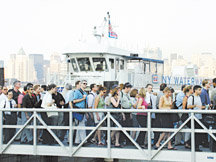Jersey City will ask the U.S. Census Bureau to change its official population count, raising questions about whether some apartment complexes or neighborhoods were missed.
The city’s population is 240,000, according to census data released earlier this year. That’s at least 20,000 people less than the city’s own projections based on new housing development and population growth throughout the city, according to city spokeswoman Jennifer Morrill. “The increase in housing units between 2000 and 2010 in Jersey City is greater than the increase in [the] 2010 census over the 2000 census,” said Morrill.
Morrill was unclear how a 20,000 boost in population might impact the federal dollars the city gets.
Many of the affected areas are filled with small, aging houses and apartment complexes
____________
The U.S. Census Bureau began accepting population challenges last month. Thus far, 23 cities across the country have filed a challenge to their 2010 census count, according to the agency’s web site. Municipalities have until June 1, 2013 to file a challenge.
Morrill said Jersey City expects to officially file its challenge later this year. The city has hired the Washington, D.C.-based nonprofit the Social Compact to spearhead its census review and challenge effort.
“Some very preliminary analysis conducted prior to the hiring of the Social Compact shows that populations in both new buildings and old buildings were undercounted,” Morrill added.
Reluctance to participate
While much of the city’s most obvious new growth took place downtown and along the waterfront, these residents likely weren’t undercounted, according to Carolina Velencia, research director for the Social Compact.
“There are many reasons why there may be an undercount,” she said. “Census workers may not have access to apartment buildings or condominiums. There can be safety issues as well. If the workers feel that an area is dangerous, they may be reluctant to work in that area. There’s also sometimes a lot of confusion about how students should be counted. Should they be counted as part of their family’s address, or counted separately where they go to school?”
And despite the big push for participation in the months leading up to the census count, many people still choose not to respond to the questionnaire and won’t cooperate with census workers, Valencia said.
The populations most likely to be undercounted are Latino and black, said Valencia, populations that historically are most likely to be missed by the census.
Many of the affected areas are filled with small, aging houses and apartment complexes, and the lack of new subdivisions may explain some of the decline.
Census workers were dispatched to housing units that did not return the forms by mail.
“We’re all a bit skeptical when we’re giving so much detailed information about our household,” she said. “For those that are undocumented, they want the least amount of contact they can have with the government.”
Never approached
Other people say they were never contacted.
Robert Feebie, who lives near Journal Square, said he did not receive a form by mail, nor was he contacted by a census worker.
“I never received anything in the mail. Of course that means I didn’t mail in their questionnaire since I never got one,” he said. “And nobody ever came to my house.”
Census workers are supposed to track down people who don’t return the forms, but Robert Bernstein, a spokesman for the Census Bureau, said human error is unavoidable. Still, Bernstein said, “We believe in the accuracy of the census and in most of the numbers we released.”
Morrill said early block-by-block comparisons already have turned up discrepancies, including several apartment buildings that appears to have been missed entirely.
Valencia said it’s not uncommon for census data showed no one living on certain blocks even though photos reveal cars on the street or in nearby parking lots
“Were these residents counted or were they missed? That’s what we will be taking a look at, because in some of these instances we find that people were not counted.”
But she and others acknowledge no count is perfect.
Valencia said Social Compact researchers and analysts will report apparent errors – apartment complexes located on blocks where no residents were reported, for example – and possible mistakes in the official count.
E-mail E. Assata Wright at awright@hudsonreporter.com.
